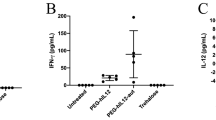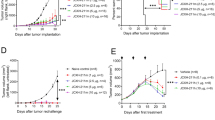Abstract
Interleukin 12 (IL-12) is a proinflammatory cytokine with antitumor activity. All-trans–retinoic acid (ATRA) exerts antitumor effects by regulating a variety of gene expressions, including tumor necrosis factor receptor 1 (TNFR1), increases the number of TNFR1 and potentiates TNF-α-induced apoptosis in cancer cells. In this study, ATRA-incorporated cationic liposome (ATRA-cationic liposome)/IL-12 plasmid DNA (pDNA) complexes were prepared to improve therapeutic efficacy of cationic liposome/IL-12 pDNA complexes in a mouse model of metastatic lung tumor after intravenous injection. IL-12 production in lungs by ATRA-cationic liposome/IL-12 pDNA complexes was comparable with that by cationic liposome/IL-12 pDNA complexes. The number of metastatic tumor cells (colon26/Luc) was quantitatively evaluated by measuring luciferase activity. ATRA-cationic liposome/IL-12 pDNA complexes reduced the number of colon26/Luc cells and tumor nodules in lungs. ATRA-cationic liposome/IL-12 pDNA complexes significantly prolonged the survival time of mice, whereas cationic liposome/IL-12 pDNA only slightly prolonged it. ATRA-cationic liposome/IL-12 pDNA complexes increased the TNFR1 mRNA upregulation and the number of apoptotic cells in the lung. Moreover, reduced serum alanine transaminase (ALT) and aspartate transaminase (AST) activities were observed in mice treated with ATRA-cationic liposome/IL-12 pDNA complexes. These results suggest that intravenous injection of ATRA-cationic liposome/IL-12 pDNA complexes is an effective method for the treatment of lung metastasis in mice.
This is a preview of subscription content, access via your institution
Access options
Subscribe to this journal
Receive 12 print issues and online access
$259.00 per year
only $21.58 per issue
Buy this article
- Purchase on Springer Link
- Instant access to full article PDF
Prices may be subject to local taxes which are calculated during checkout






Similar content being viewed by others
Accession codes
References
Colombo MP, Trinchieri G . Interleukin-12 in anti-tumor immunity and immunotherapy. Cytokine Growth Factor Rev 2002; 13: 155–168.
Dow SW, Elmslie RE, Fradkin LG, Liggitt DH, Heath TD, Willson AP et al. Intravenous cytokine gene delivery by lipid-DNA complexes controls the growth of established lung metastases. Hum Gene Ther 1999; 10: 2961–2972.
Car BD, Eng VM, Lipman JM, Anderson TD . The toxicology of interleukin-12: a review. Toxicol Pathol 1999; 27: 58–63.
Krieg AM, Yi AK, Matson S, Waldschmidt TJ, Bishop GA, Teasdale R et al. CpG motifs in bacterial DNA trigger direct B-cell activation. Nature 1995; 374: 546–549.
Loisel S, Le Gall C, Doucet L, Ferec C, Floch V . Contribution of plasmid DNA to hepatotoxicity after systemic administration of lipoplexes. Hum Gene Ther 2001; 12: 685–696.
Sakurai F, Terada T, Yasuda K, Yamashita F, Takakura Y, Hashida M . The role of tissue macrophages in the induction of proinflammatory cytokine production following intravenous injection of lipoplexes. Gene Therapy 2002; 9: 1120–1126.
Kawakami S, Ito Y, Charoensit P, Yamashita F, Hashida M . Evaluation of proinflammatory cytokine production induced by linear and branched polyethylenimine/plasmid DNA complexes in mice. J Pharmacol Exp Ther 2006; 317: 1382–1390.
Ito Y, Kawakami S, Charoensit P, Higuchi Y, Hashida M . Evaluation of proinflammatory cytokine production and liver injury induced by plasmid DNA/cationic liposome complexes with various mixing ratios in mice. Eur J Pharm Biopharm 2009; 71: 303–309.
Janat-Amsbury MM, Yockman JW, Anderson ML, Kieback DG, Kim SW . Combination of local, non-viral IL12 gene therapy and systemic paclitaxel chemotherapy in a syngeneic ID8 mouse model for human ovarian cancer. Anticancer Res 2006; 26: 3223–3228.
Zhu S, Waguespack M, Barker SA, Li S . Doxorubicin directs the accumulation of interleukin-12-induced IFNγ into tumors for enhancing STAT1 dependent antitumor effect. Clin Cancer Res 2007; 13: 4252–4260.
Rowinsky EK, Cazenave LA, Donehower RC . Taxol: a novel investigational antimicrotubule agent. J Natl Cancer Inst 1990; 82: 1247–1259.
Denis R, Vincent D, Jérôme Q, Florence ML, JeanPierre D, Philippe R et al. Preclinical toxicity, toxicokinetics, and antitumoral efficacy studies of DTS-201, a tumor-selective peptidic prodrug of doxorubicin. Clin Cancer Res 2008; 14: 1258–1265.
Strickland S, Mahdavi V . The induction of differentiation in teratocarcinoma stem cells by retinoic acid. Cell 1978; 15: 393–403.
Lotan R, Francis GE, Freeman CS, Waxman S . Differentiation therapy. Cancer Res 1990; 50: 3453–3464.
Tallman MS, Nabhan C . Management of acute promyelocytic leukemia. Leukemia 2002; 4: 381–389.
Freemantle SJ, Spinella MJ, Dmitrovsky E . Retinoids in cancer therapy and chemoprevention: promise meets resistance. Oncogene 2003; 22: 7305–7315.
Mirza N, Fishman M, Fricke I, Dunn M, Neuger AM, Frost TJ et al. All-trans-retinoic acid improves differentiation of myeloid cells and immune response in cancer patients. Cancer Res 2006; 66: 9299–9307.
Adès L, Chevret S, Raffoux E, de Botton S, Guerci A, Pigneux A et al. Is cytarabine useful in the treatment of acute promyelocytic leukemia? J Clin Oncol 2006; 24: 5703–5710.
Boorjian SA, Milowsky MI, Kaplan J, Albert M, Cobham MV, Coll DM et al. Phase 1/2 clinical trial of interferon α2b and weekly liposome-encapsulated all-trans retinoic acid in patients with advanced renal cell carcinoma. J Immunother 2007; 30: 655–662.
Soriano AO, Yang H, Faderl S, Estrov Z, Giles F, Ravandi F et al. Safety and clinical activity of the combination of 5-azacytidine, valproic acid, and all-trans retinoic acid in acute myeloid leukemia and myelodysplastic syndrome. Blood 2007; 110: 2302–2308.
Montesinos P, Bergua JM, Vellenga E, Rayón C, Parody R, de la Serna J et al. Differentiation syndrome in patients with acute promyelocytic leukemia treated with all-trans retinoic acid and anthracycline chemotherapy: characteristics, outcome, and prognostic factors. Blood 2009; 113: 775–783.
Soprano DR, Qin P, Soprano KJ . Retinoic acid receptors and cancers. Annu Rev Nutr 2004; 24: 201–221.
Manna SK, Aggarwal BB . All-trans-retinoic acid upregulates TNF receptors and potentiates TNF-induced activation of nuclear factors-κB, activated protein-1 and apoptosis in human lung cancer cells. Oncogene 2000; 19: 2110–2119.
Datta PK, Lianos EA . Retinoic acids inhibit inducible nitric oxide synthase expression in mesangial cells. Kidney Int 1999; 56: 486–493.
Kim BH, Kang KS, Lee YS . Effect of retinoids on LPS-induced COX-2 expression and COX-2 associated PGE2 release from mouse peritoneal macrophages and TNF-α release from rat peripheral blood mononuclear cells. Toxicol Lett 2004; 150: 191–201.
Motomura K, Sakai H, Isobe H, Nawata H . All-trans retinoic acid suppresses liver injury induced by propionibacterium acnes and lipopolysaccharide in rats. J Gastrol Hepatol Commun 1997; 12: 887–892.
Oseto S, Moriyama T, Kawada N, Nagatoya K, Takeji M, Ando A et al. Therapeutic effect of all-trans retinoic acid on rats with anti-GBM antibody glomerulonephritis. Kidney Int 2003; 64: 1241–1252.
Charoensit P, Kawakami S, Higuchi Y, Hashida M . Incorporation of all-trans retinoic acid into lipoplexes inhibits nuclear factor κB activation mediated liver injury induced by lipoplexes in mice. J Gene Med 2008; 10: 61–69.
Nishikawa M, Hyoudou K, Kobayashi Y, Umeyama Y, Takakura Y, Hashida M . Inhibition of metastatic tumor growth by targeted delivery of antioxidant enzymes. J Control Release 2005; 109: 101–107.
Kuramoto Y, Nishikawa M, Hyoudou K, Yamashita F, Hashida M . Inhibition of peritoneal dissemination of tumor cells by single dosing of phosphodiester CpG oligonucleotide/cationic liposome complex. J Control Release 2006; 10: 226–333.
Hyoudou K, Nishikawa M, Umeyama Y, Kobayashi Y, Yamashita F, Hashida M . Inhibition of metastatic tumor growth in mouse lung by repeated administration of polyethylene glycol-conjugated catalase: quantitative analysis with firefly luciferase-expressing melanoma cells. Clin Cancer Res 2004; 10: 7685–7691.
Suzuki S, Kawakami S, Chansri N, Yamashita F, Hashida M . Inhibition of pulmonary metastasis in mice by all-trans retinoic acid incorporated in cationic liposomes. J Control Release 2006; 116: 58–63.
Kawakami S, Suzuki S, Yamashita F, Hashida M . Induction of apoptosis in A549 human lung cancer cells by all-trans retinoic acid incorporated in DOTAP/cholesterol liposomes. J Control Release 2006; 110: 514–521.
Wang H, Xu DX, Lu JW, Zhao L, Zhang C, Wei W . N-acetylcysteine attenuates lipopolysaccharide-induced apoptotic liver damage in D-galactosamine-sensitized mice. Acta Pharmacol Sin 2007; 28: 1803–1809.
Mahato RI, Kawabata K, Nomura T, Takakura Y, Hashida M . Physicochemical and pharmacokinetic characteristics of plasmid DNA/cationic liposome complexes. J Pharm Sci 1995; 84: 1267–1271.
Osaka G, Carey K, Cuthbertson A, Godowski P, Patapoff T, Ryan A et al. Pharmacokinetics, tissue distribution, and expression efficiency of plasmid [33P]DNA following intravenous administration of DNA/cationic lipid complexes in mice: use of a novel radionuclide approach. J Pharm Sci 1996; 85: 612–618.
Agresti C, Bernardo A, Del Russo N, Marziali G, Battistini A, Aloisi F et al. Synergistic stimulation of MHC class I and IRF-1 gene expression by IFN-γ and TNF-α in oligodendrocytes. Eur J Neurosci 1998; 10: 2975–2983.
Berger AC, Alexander HR, Wu PC, Tang G, Gnant MF, Mixon A et al. Tumour necrosis factor receptor I (p55) is upregulated on endothelial cells by exposure to the tumour-derived cytokine endothelial monocyte- activating polypeptide II (EMAP-II). Cytokine 2000; 12: 992–1000.
Zhou J, Zhang M, Atherton SS . Tumor necrosis factor-alpha-induced apoptosis in murine cytomegalovirus retinitis. Invest Ophthalmol Vis Sci 2007; 48: 1691–1700.
Car BD, Eng VM, Schnyder B, LeHir M, Shakhov AN, Woerly G et al. Role of interferon-γ in interleukin 12-induced pathology in mice. Am J Pathol 1995; 147: 1693–1707.
Motomura K, Isobe H, Sakai H, Nawata H . Suppressive effects of all-trans retinoic acid on the lipopolysaccharide-stimulated release of tumor necrosis factor-á and nitric oxide by rat Kupffer cells in vitro. Int Hepatol Commun 1996; 5: 177–183.
Acknowledgements
This work was supported in part by grants-in-aid for scientific research from the Ministry of Education, Culture, Sports, Science, and Technology of Japan, and by Health and Labour Sciences Research Grants for Research on Advanced Medical Technology from the Ministry of Health, Labour and Welfare of Japan and by the Radioisotope Research Center of Kyoto University.
Author information
Authors and Affiliations
Corresponding author
Ethics declarations
Competing interests
The authors declare no conflict of interest.
Rights and permissions
About this article
Cite this article
Charoensit, P., Kawakami, S., Higuchi, Y. et al. Enhanced growth inhibition of metastatic lung tumors by intravenous injection of ATRA-cationic liposome/IL-12 pDNA complexes in mice. Cancer Gene Ther 17, 512–522 (2010). https://doi.org/10.1038/cgt.2010.12
Received:
Revised:
Accepted:
Published:
Issue Date:
DOI: https://doi.org/10.1038/cgt.2010.12
Keywords
This article is cited by
-
CNS Delivery of Nucleic Acid Therapeutics: Beyond the Blood–Brain Barrier and Towards Specific Cellular Targeting
Pharmaceutical Research (2023)
-
A novel method for the development of plasmid DNA-loaded nanoliposomes for cancer gene therapy
Drug Delivery and Translational Research (2022)
-
Interleukin 12: still a promising candidate for tumor immunotherapy?
Cancer Immunology, Immunotherapy (2014)
-
Gene therapy for cardiovascular disease mediated by ultrasound and microbubbles
Cardiovascular Ultrasound (2013)
-
Emerging biotechnological strategies for non-viral antiangiogenic gene therapy
Angiogenesis (2012)



